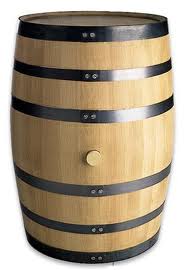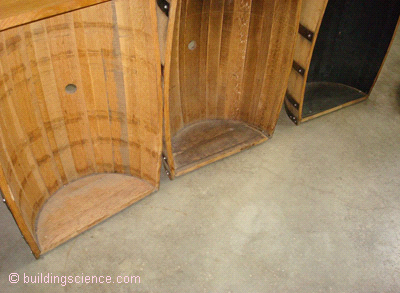Bourbon Aging Explained
Bourbon Aging Explained
Everyone loves Bourbon because of its sweet and complex flavors. But, where do all of those flavors come from. This post will explain how Bourbon aging works and what flavors this process adds to the Bourbon. FYI, I refer to “distillate” several times in the article. This is the Bourbon after it has been distilled but before it has entered the barrel for aging. I use the word distillate since it is not Bourbon until it has been aged in new oak barrels.
Under federal standards after Bourbon is distilled it must enter in to charred new oak barrels for aging at no greater than 125 proof (62.5%). To be Straight Bourbon the Bourbon must be aged for at least 2 years. When the distillate (soon to be Bourbon) comes off of the still it is clear and only contains the flavor of the grains it was distilled from. Multiple distilleries are currently offering unaged whiskey but I would suggest saving your money. The barrel is where the Bourbon magic occurs. What happens in these barrels? How can something that taste similar to rubbing alcohol go in to charred oak barrels, sit in a warehouse for years and emerge as something so delicious? It’s magic….or science? Maybe, a mixture of the two?
Bourbon Barrels
Let’s start with the barrel or cask. Standard Bourbon barrels are 53 gallon and assembled (largely by hand) of New White Oak. The barrel does not have to be 53 gallons but generally they are. The “New” references the fact that they have not been used before. The majority of distilleries use the same barrel manufacturer, Independent Stave Company. Watch their video to see exactly how the barrels are made. It is an interesting process. It is no surprise that Bourbon gets its oak and woody flavors from these barrels. After the barrels are used for Bourbon they are usually shipped to Scotland to be used for aging by Scotch distilleries. They have also become a popular option for breweries and wineries as well. Because Bourbon uses new barrels the aging time for Scotch is usually much longer.
The Char
Each barrel is charred or toasted on the inside. There are multiple levels or charring and the level varies by distillery. A charred barrel is what gives Bourbon that slightly charred or smoky taste. It also adds sweetness with toffee and vanilla notes because the sugars in the wood caramelize during the charring process. Most distilleries use what is known as a number 4 char. Flames are shot through the barrel for 55 seconds to obtain a level 4 char. Below, we have and uncharred, medium charred and heavy charred barrels:
Distillate
Now that the barrels are ready it is time for them to be filled with the distillate. A lot of consideration goes in to this step as well. A high-alcohol concentration, such as 160 proof, extracts more of the beneficial compounds and color, but it also extracts more tannin. These tannins are what contribute to the harsh flavor in some Bourbons. Almost all distilleries now use a barrel entry proof of between 110 and 125 proof (Buffalo Trace uses 125 for all their Bourbon whereas other Distilleries change the entry proof depending on the Bourbon). This range in proof creates a good balance of beneficial compound extraction, color and tannin’s.
The Warehouse
After the distillate/bourbon is added to the barrels they are left to age and mature in bourbon warehouses or rick house. Major distilleries have multi floor warehouses with multiple rick levels where the barrels sit. Here is the amazing thing about Bourbon aging. Identical Bourbons aged for the same period of time in separate parts of the warehouse can taste drastically different. That is because of the way temperature affects the barrels. There is no temperature regulation in the warehouses so during the winter the barrels contract and then expand during the summer heat. Essentially, breathing in and out small Bourbon. Because of this, Bourbon evaporates and the distilleries experience what is known as the “Angels Share”. Angels share is the portion of Bourbon (or, any alcohol that is aged) that is lost to evaporation during the aging process.
Let’s use the 2013 release of George T. Stagg from the Buffalo Trace Antique Collection as an example. Buffalo Trace selected 157 barrels for the 2013 release. That’s 8,321 gallons of Bourbon which was reduced down to 2,218 gallons after 15 years and 11 months of aging. That is a decrease of 73.34%! Some of this loss is due to leakage but the majority of it is from evaporation That just means that all of those flavors have been reduced down to a much more concentrated liquid. Also, George T. Stagg Bourbon enters the barrel at 125 proof and exits at its bottled proof of 128.2. This difference can be even greater if the Bourbon is aged in a higher level of the warehouse.
While all steps in the Bourbon making process are important the aging process plays a huge role in the final product. Now you know how Bourbon goes from undrinkable to something that is smooth and complex.
Start Building a Bourbon Library




19 comments
Info on bourbon excellent!
Left margin on Facebook, Twitter, etc obscuring text is a real bummer!
Are you on mobile or desktop? I’ll try to fix
I’m on a desktop and it’s still there!
What a great summary! I’ve been reading your blog for about 1 year and you are my “go to” blog for all things Bourbon. Well done!
Any thoughts on how location in the rickhouse affects flavor? My local store is getting a barrel of rye that came from the top floor. I know the heat will cause more evaporation and higher proof, but are there any good / bad effects like over oaking? I’ve heard the middle is best for single barrels and top and bottom go to blends to strike a balance.
Generally, the higher in the rick house the hotter it is since more liquid than alcohol evaporates. Just out this post here for a little more detail http://bourbonr.com/blog/3-levels-wheated-bourbon/
Do you know if there would be any benefit to aging the bourbon in caves, like is done at many wineries, to reduce the angels share and have more control over the aging temperature?
It would definitely change the bourbon flavor profile. Wild Turkey is getting ready to release a bourbon called Master’s Keep. It was aged in a stone building and even at barrel strength its still only 86 proof. Can we age some bourbon in your caves to test?!
Send me an email and we will see what we can set up. Loved the article.
How can you tell what level char is used for each Whiskey. Do distilleries use the same level char for all there whiskies?
Hi Blake, I just purchased a 2 and 3 liter bourbon barrels. Should I age them on my back porch or in spare room which stays at 78°. Using weller special reserve trying to double it’s age. Any ideas?
Thanks Andre
Does anybody know if they fill the barrels 100% full when they add the distillate? Is there a certain amount of air space that they want to have right from the beginning? I’ve always wondered. And secondarily, it has a minor affect on the calculations if a barrel doesn’t really start out with 53 gallons in it. Thanks, Mark
Do you know of any books or literature on the topic. I am trying to understand the different taste notes or other characteristics the spirit goes through as it ages.
So that one might try to replicate it on a smaller scale.
Also any information about the differences noticed between these “quick” stick aging processes and the long (time) barrel process.
Thank you in advance for any insight you might have.
John T
Regards for this marvellous post, I am glad I noticed
this internet site on yahoo.